FREIGHT CARS | CABOOSE & CABIN CARS |
Brief history. A very essential part of rail transport around the world is obviously the ROLLING STOCK, the hauled component formed of freight cars with all its variants specialized for every type of load to be transported and the coaches for transporting passengers, including the variants for baggage and express mail. BOXCARS The boxcar is the most common type of freight car used since the beginning of the american railroads. Thousands and thousands of boxcar were built by many industries to put in service on the tracks the better way for carrying every kind of goods. There are many types of boxcar, built using wood or metal frame, with different lenght and capacity. The classification of those freight cars type has been done following the main characteristics and taking names and different classes, within each railway companies. 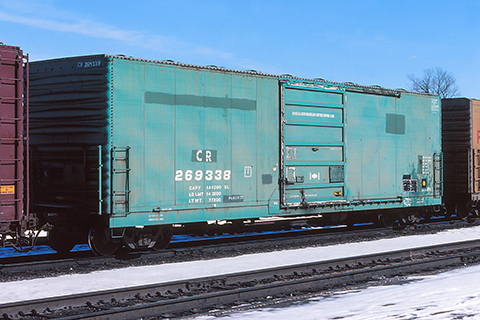 X72 class boxcar Conrail #269338. 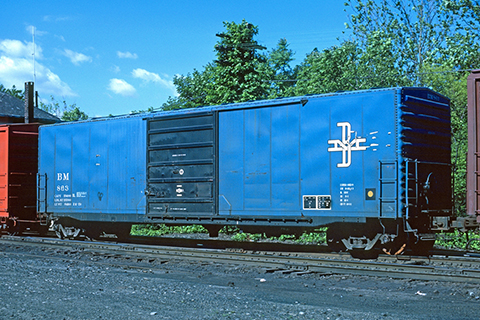 PS-1 50' boxcar Boston & Maine #863. 40' X26 class single sheathed USRA wood boxcar PRR #564543 (built 1919)  The PRR X26 class of wood boxcar was derivated by a model designed by USRA (United States Railroad Administration) since 1910. The "Pennsy" acquires its first variant of this boxcar beetwen 1919-1920, following the X25 class that was the first series of this boxcar type. 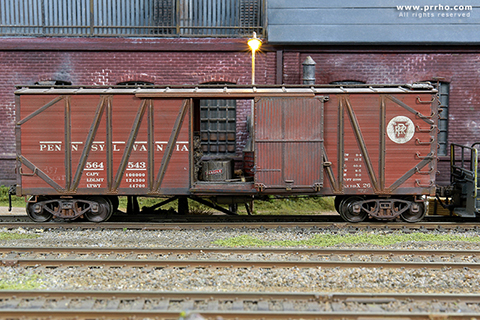 Tichy Train Group RTR Series PRR X26 class boxcar. 40' Mather wood boxcar IN #2023 (built 1948) From the 1920s through the 1950s, when freight car manufacturing and leasing were largely the province of big corporations like General American and American Car & Foundry, the Mather Company remained relatively small, privately owned and presided over by its namesake, Alonzo C. Mather. Using proven designs and off-the-shelf components, his company cranked out utilitarian cars using a minimum of specialized components or machine tools. The hand-built cars were cheap to build and maintain, so the company flourished because its cars could be leased at very competitive rates. Because railroads couldn't afford new cars from the major builders, the Mather Company's shops built or rebuilt many box cars for lease during the Depression. These cars remained in service through World War II and, updated with AB air brakes and more modern trucks, many of them lasted through the 1950's and into the 1960's, by which time the Mather Company had been acquired by the North American Car Company. With their distinctive Mather construction and sheet metal Mather Patent roofs, they could be seen all across the North American railroad network. 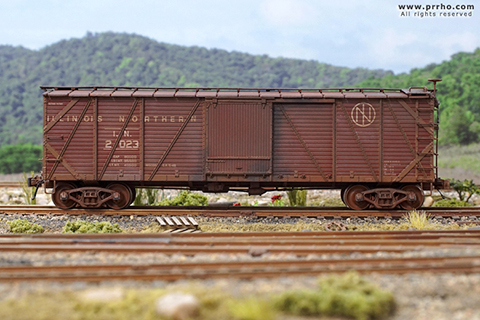 Walthers Proto Mather wood boxcar. 40' X26c class USRA steel rebuilt boxcar PRR #105808-#105530 (built 1919)  By the beginning of WWII, the majority of the classic USRA double-sheathed box cars and their clones were rebuilt with steel sides. More rebuilds followed in the late 1940s and early 1950s. By late 1948, close 14.000 of the original 24.500 USRA double-sheathed cars had been rebuilt with quite a degree of variation including the end, door and underframe. These steel side rebuilds were far more popular than their single-sheathed counterparts. 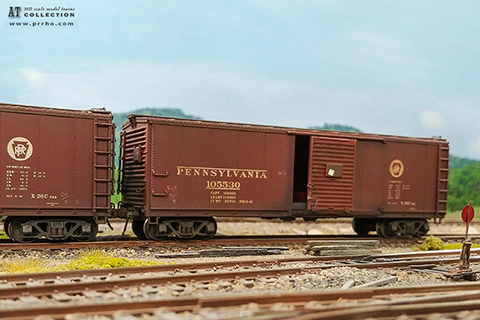 Atlas Master Line PRR X26c class boxcar. 40' X29 class 50-ton all steel boxcar PRR #100467-#100554-#101801 (built 1934)  In 1923, the ARA (American Railway Association) proposed a standard design all-steel box car for the american railroads. The largest fleet of these freight cars, was undoubtedly purchased by the Pennsylvania Railroad. PRR assigned to this car the designation X29 class (sub-classes were developed). In 1957 remain in service over 30,000 cars, used throughout the huge PRR network, used for the transport of any goods not perishable. 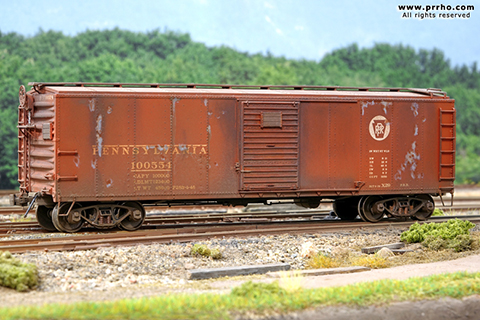 Red Caboose PRR X29 class boxcar. 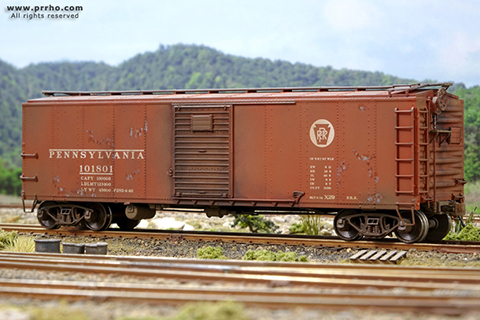 Red Caboose PRR X29 class boxcar. 40' modified AAR boxcar ERIE #80268 (built 1941)  The 1944 AAR boxcar is an evolution of 1937 design. The primary variations are the updated ends, known as "dreadnaught ends". Other changes have involved many exterior details as ladders, the panel roof and about only some units and the new doors (Superior model door and Youngstown door with different sizes). ERIE Railroad sold many hundreds of this boxcar type, put in service to carry not perishables goods. 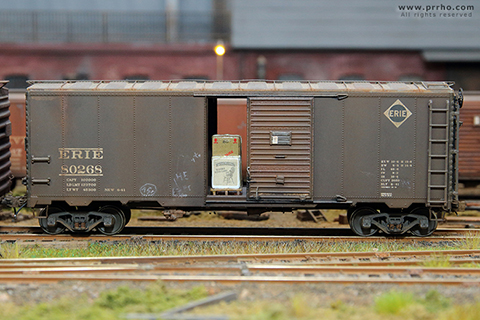 Intermountain Railway Co. AAR boxcar. 40' PS-1 single door 8' Youngstown boxcar N&W #44263 (built 1951) 40' PS-1 boxcar with 7' 5-Panel Superior Door MONON #859 (built 1953)   Pullman-Standard built thousands of ARA and AAR boxcars through the mid-1940s, but in 1947 P.S. began producing its PS-1 line of boxcars. Basically, these new boxcars were further developments of 1944 AAR design, built in 40- and 50-foot lenghts. The PS-1 boxcar proved immensely popular with over 75.000 cars produced for 79 railroads and private owners. 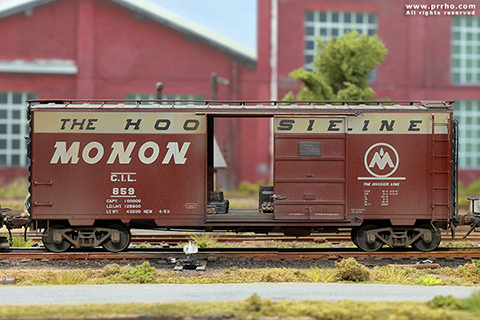 Kadee PS-1 boxcar. 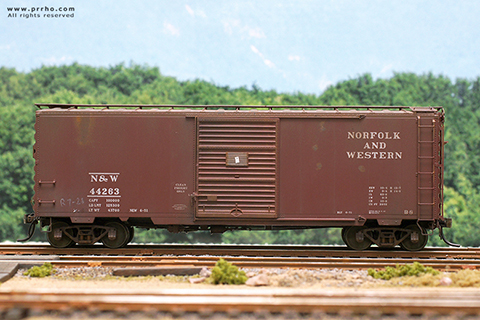 Kadee PS-1 boxcar. M-53 wagon-top boxcar B&O #380934-#1924 R.E.A. (built 1937)  The design of the Baltimore & Ohio Railroad wagontop boxcars was one of the true innovations in boxcar production during the entire history of american railroading. The B&O created express boxcars from the M-53 class wagontop to meet the increased demand for mail storage and Railway Express Agency movements surrounding World War II. The production of new C-16 class beginning in 1937. The first 25 M-53s were re-equipped with steam and signal lines and additional vertical and lateral grab irons on the ends. From 1937 the B&O also constructed 2,000 additional Wagontops, classed M-53, numbers 380000-381999. In 1953 an additional 1,000 cars were built as class M-53A and numbered 385000-385999. Following, a total of 125 were converted from 1941 to 1945. 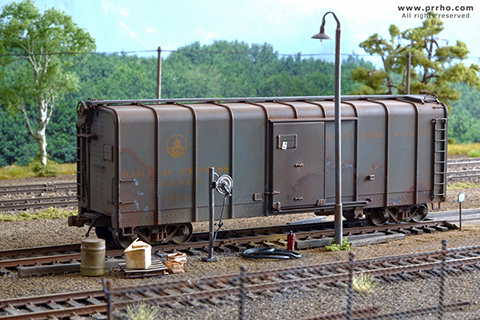 Fox Valley Models M53 Wagontop boxcar. 50' X44 class post-war single door boxcar PRR #604419 (built 1951)  At the end of Second World War, railroads ordered large numbers of 50' AAR boxcars with a standard design that was first widely used in the late 1940s. This design was based on the original 1937 AAR design but was modified in the post-war era to include: improved dreadnaught end and diagonal panel roofs with standard or overhanging design. These 50' boxcars were a common sight on american railroads well into the 1970s and 1980s. Pennsylvania Railroad called this 50' boxcar X44 class. 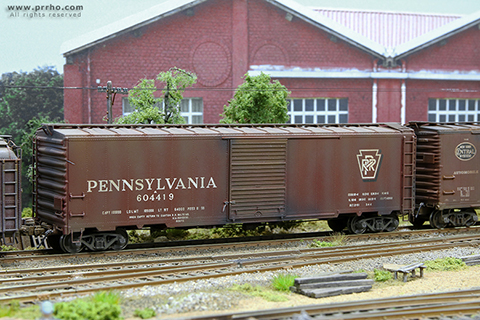 Atlas Master Line PRR X44 class boxcar. 50' automobile "double door" boxcar NYC #64474-#64184 (built 1941)  Originating in the 1890, 50' boxcars were adapted to the needs of the automotive industry early in the 20th century with double side doors for easy loading at docks and ramps. In 1942, the Association of American Railroads (AAR) adopted a new standard all-steel design that included the latest pressed steel ends and doors.  Walthers Proto Automobile boxcar. 50' X58 class boxcar PRR #113347 (built 1966) 50' X58 class boxcar PC #265753 (built 1974) 50' X58 class boxcar CR #229723 (built 1976) 50' X58 class boxcar LV #8210 (built 1965)     The X58 Class boxcar was one of the Pennsylvania's largest classes of boxcars. At the Penn Central merger, just over 2,000 X58 and their subclasses were in service. Many X58 survived onto Conrail with the original heritage colors (CR patched) and/or repainted, as some units in former Lehigh Valley white livery. 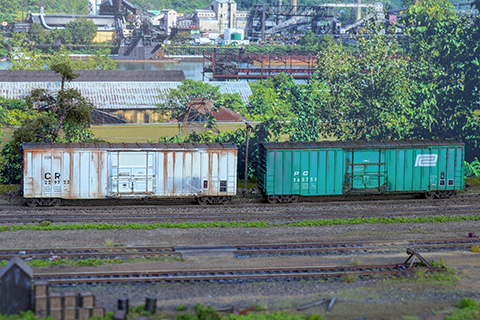 Tangent Scale Model X58 class boxcars. 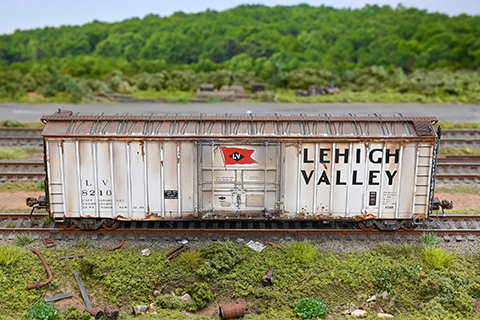 Tangent Scale Model X58 class boxcar. 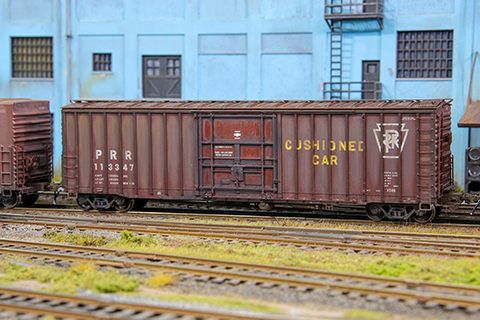 Tangent Scale Model X58 class boxcar. 50' G.A. RBL Sill 1 10'6" Offset Door Narrow Rods boxcar N&W #693577 (built 1963)  In 1962 General American Corp. began building its most popular insulated boxcar models, a refinement of their proven 1950s design. One of the most important developments for this type of car was the all-welded body structure, where only the roof was bolted on after insulation. Other features included 20-inch cushioned underframes and a variety of load restraining devices for customer specifications. 50' PS-1 boxcar BM #77064 (built 1956 - repaint 1977)  Pullman Standard built the longer version of its 40' PS-1 boxcar from 1952. The greatest variation was in the size and style of doors used. Later, Pullman Standard also offered 60′ boxcars – also with the PS-1 designation. 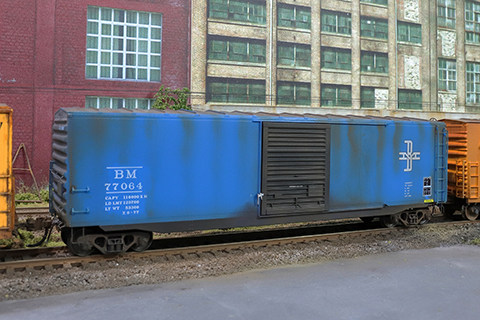 Kadee PS-1 boxcar. 50' PC&F SS boxcar with 14' Plug Door SP/UP #850110 (built 1974)   Bunkerless box/reefer car (built by Pacific Car & Foundry in many hundreds units) with or without ventilating devices and with or without device for attaching portable heaters. Construction with insulation in side ends, floor and roof to meet maximum UA factor requirement of 250 BTU/F/Hour for this type 50 foot cars. Equipped with adjustable loading or stowing device. 50' FMC-5077 single-door boxcar RB #17721 (built 1975) 50' FMC-5077 single-door boxcar RB #18407 (built 1975)  The boxcar with the single-sliding door configuration is one of the best known and used widely by many different railroads. These cars were produced using the Gunderson metal works which FMC had acquired in 1965. In late 1975, FMC began producing a 5,077-cubic-foot Plate B boxcar for IPD and Railbox services. Railbox Company (reporting marks ABOX, RBOX, TBOX, FBOX) was founded in 1974, created to address a boxcar shortage in the United States in the 1970s. It is a subsidiary of the Chicago-based TTX Company. 50' N.A.C.C. plug-door boxcar CNJ #41030 (built 1964) 50' N.A.C.C. plug-door boxcar QOCX #330 (built 1966)   The 50' NACC boxcar was designed and built by the North American Car Corporation (NACC) in the early 1960s. The car was an insulated boxcar (equipped with a plug-door) used to carry various commodities that are temperature sensitive. The plug door offers better sealing of the car to maintain temperature and better protection from weather, theft, and other possible damages. Several railroads rostered this car with most of them either purchased by or leased to private shippers (as QOCX to transport foods and cereals). 60' X77 class 70-ton Berwick 7440 Appliance boxcar PC #278129 (built 1974)  This Hi-cube car was built and delivered in 1973 by the Berwick Forge and Fabricating Corporation in the former AC&F Berwick, Pennsylvania plant. Penn Central was the largest buyer and took delivery of 130 of them (equipment series 278045 - 278174). The Illinois Central Gulf, Norfolk & Western and Rock Island also acquired a handfull each. 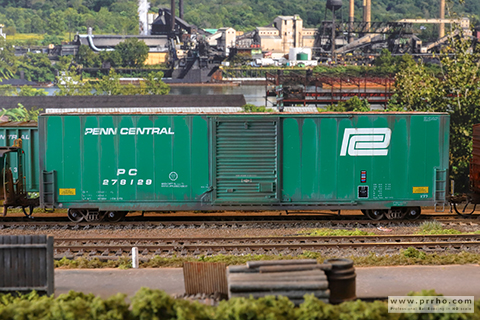 Exactrail X77 class boxcar. COVERED HOPPERS Covered hoppers are very special freight cars common to many North American railway companies, built in very large numbers. Utilized to transport dense and heavy granular products like cement, clay, potash, and sand. In the United States, the leading manufacturer of covered hopper wagons is the Pullman-Standard Car Manufacturing (Pullman Company). The 4000 cubic foot PS-2CD indoor hopper was manufactured by P-S (first type developed) between 1962 and 1964 in the Butler's, PA, shops. These cars had a very long useful life, with some remaining in income service in the United States, Canada and Mexico until the early 2000s. One of the most distinctive Pullman-Standard covered hoppers, this common 90/100ton car it was mainly used for cereals, malt, fertilizers and similar services. H30 class 3-bay covered hopper PC #32349 "sand service" (built 1936 PRR, rebuilt 1969 PC)  The Pennsylvania Railroad started building 70-ton H30 class covered hoppers around 1935. During the Sixty years, the capacity of the remaining cars was increased to 77tons from 70tons. At the time of merging between the Pennsylvania Railroad and the New York Central Railroad, with the creation of the Penn Central company, remained in service around 1.000 exemplaries of H30. Many "sand service" H30 covered hoppers were used on the first years of Conrail era. PS-2 4427 "High Side" Covered Hopper EJ&E-RI restencil #131016 (built 1974)   Developed from "low-side" variant, the series 4427 “High Side” production ended in 1971 after delivery of approximately 12,000 cars. Built by Pullman-Standard in some thousands units, these covered-hopper cars met the needs of rail freight shippers for bulk transport. FLATCARS Since the beginning of the American railroad the flatcar have been used to transport nearly all bulk products, including machinery, pipes, pulp, and lumber. Used for general services, the deck has been built entirely of steel since the early 1900s. The USRA (United States Railroad Administration) designed a 55 ton / 42 foot flat car and some 8,000 cars were built. Many other variations followed; for example, 50 tons / 46 feet and 70 tons / 53 feet, built by AAR (Association of Railroads) and Pullman-Standard between 1940-1950. Other types of flatcars were those adapted for the transport of trailers and containers (piggyback trains). F60-GH class 60' trailer train flatcar HTTX #91534 (built 1968) F60-GH class 60' trailer train flatcar HTTX #93226 (built 1968)  TTX Company (formerly TrailerTrain and founded by Pennsylvania Railroad and Norfolk & Western Railway) a provider of railcars and its "trailer flat cars" are the main option for many railroads about "piggybacking" train services. From 1956 over 165.000 cars (flatcars, boxcars and gondolas) were built and leased at the major american railroads. Between 1964-1975, TrailerTrain (now known as TTX Co.) acquired a fleet of 5.000 modern 60' flats built by ACF, Thrall and Pullman Standard. TTX cars were assigned to various classes to handle loads as auto frames, logs, military vehicles, farm equipment and construction equipment. Some were even modified to handle TTX's bread and butter, intermodal containers. GONDOLA CARS The gondola car in North American railroad terminology, is an open roof rail vehicle used to transport bulk materials, such as metal scrap, stone, lumber, or others type heavy loads. Due to their low side walls, the gondolas are also suitable for transporting high density loads such as steel plates or coils, or bulky items such as prefabricated sections of track. During many years many types of gondolas were built, follows the needs of each individual railroads. G43 class corrugated side PRR #387684 (built 1966) G43A class corrugated side PC #576941 (built 1968) G43B class corrugated side PC #564480 (built 1969)   The G43 gondola class was a 52-foot, 6-inch interior length corrugated-side gondola first saw production in 1966. Initially produced with a design based on "all panel corrugated", the following sub-classes later they had some changes. The variant G43b have no corrugations in the outward two panels, as well as DSI (Despatch Shops, Inc., Rochester NY) corrugated ends. The Pennsylvania Railroad and merger successor Penn Central built a total of 3.750 G43 / G43A / G43B / G43C gondolas at the Sam Rea Shops in Hollidaysburg, PA, from 1966 to 1970. Bethlehem 70-Ton riveted drop-end LV #32904 (built 1950 repaint 1973) Bethlehem 70-Ton riveted drop-end LV #37076 (built 1952 repaint 1970)  This 52.6-foot (over 16-meter) long, 70-ton tipper gondola type was designed and manufactured by Bethlehem Steel for the first time in March 1937 on demand by the Baltimore & Ohio Railroad company. This car, referred to as the "O-59 class gondola car" for B&O, was built in over 4,000 units. Other railway companies bought these "Bethlehem" gondolas in the following years, until production ceased in 1957. They are used intensively, mostly by companies operating in highly industrialized eastern countries rich in foundries, for the transport of metal scrap and, not infrequently, coal and other natural materials such as crushed stone. Most of these gondolas were gradually withdrawn from service in the mid-1980s, replaced by more modern models. 65'6" Mill Gondola CR #593300 (built 1977)  First built by General American in the early 1940’s, the mill gondola was designed for steel mill shipments that required extra length and versatility. The sturdy riveted construction could carry the necessary weight plus both end panels were hinged to fold inward. This allowed long beams and other extra-length loads to extend beyond the length of the car. When carrying such loads, the mill gondola requires flat cars coupled to both ends to allow clearance of the overhanging load. OPEN HOPPERS The open hopper car is a main actor of railroading history. Coal is undoubtedly one of the most important goods transported by trains since the dawn of rail transport. The first "open hoppers" used, called "jimmies" by the railway pioneers, were essentially a little two-axle cars used on mule-powered railroads of the 1820's and 1830's to haul about 1.5 tons of coal (3,000 pounds) from mines to a nearby canal or river. The little jimmies carried the basic features of the modern hopper that differentiates it from the gondola. However, the early hoppers were essentially an extravagant version of a gondola car. The first original hoppers with unloading of coal through a doublel-bay system, appeared in the mid of XIX century. With the new century, thanks mainly to the change from wood to iron/steel in the construction of rail cars, were built models with capacity up to 55 tons, which were the standard until the advent of the 4-bay hopper car with greater length and increased load from 70 to 100 tons. 55-ton GLA class USRA two-bay hopper PRR #220149-#220158 (built 1919)  Over 22.000 units of this hopper car were delivered by the U.S.R.A. to 23 railroads. This familiar car is the most long lived and successful USRA design. Many were in still service into the "sixties" and some even into the "seventies". 70-ton H21a class 4-bay coal hopper PRR #177060 (built 1916)  In 1911 thru 1917, the 70ton H21 "quad" hoppers were introduced for coal and coke services, by PRR and others railroads. During 1922 and 1923, all early H21 hoppers were converted to H21a's by replacing the 50ton trucks with 70ton trucks, equipping them for coal service and bringing the total to 36,000 H21a hopper cars. 70-ton H22a class four-bay hopper car PRR #410435 (built 1930)  The H-22a was a converted H-22 coke car, beginning in 1923. The H-22 was originally built with clam shell doors but were converted to saw tooth doors as shop repairs were required. Carrying capacity was increased to 140,000 pounds of coke. 3671 H-22A's were converted by 1930. REFRIGERATOR CARS Essentially a boxcar refrigerated, the reefer (refrigerator car) was designed to carry all perishable goods. The first refrigerator cars were being tested on the Northern Railroad in 1851, in New York. These cars featured some type of insulation and blocks of ice to keep the contents cool. The common merchandise carried were fruits, dairy, meat, and vegetables. Many railroads put in service huge quantities of reefer cars, at least until the beginning of the sixties. Following, the increase in traffic on the road caused a significant reduction in the use of rail transport of perishable goods, especially for short and medium distances. 40' wood reefer BAR #6540 (built 1931)  Early “reefers” were of all wood construction and about 36’ long. The first 40 'model appeared from the end of the Second World War, built in wood but equipped with normal wood ends or new steel "dreadnaught" ends. As with box car development, steel components were incorporated into construction as technology improved. Stamped steel ends were added to the refrigerator cars to strengthen the body. “Double sheathing” remained a prominent part of the construction to insure maximum insulating properties. Equipped with steel roofs and Bettendorf trucks, these “reefers” could still be seen in trains during the 50’s. 40' wood-side refrigerator car MDI #17217 (built 1936)  40' insulated reefer FGEX #37363 (built 1954)  Fruit Growers Express (FGE) was a railroad refrigerator car leasing company. In 1919 the Federal Trade Commission forced the breakup of the Armour Refrigerator Line due to unfair competition. As a result, FGE was incorporated in Delaware on March 18, 1920, based out of Washington, D.C. to provide a shared reefer pool for the benefit of the ACL, B&O, PRR and Southern Railroads. Additional railroads later joined: New Haven and N&W (1920), L&N and FEC (1923), C&O (1927), NYO&J (1931), and Pere Marquette (1940). In the 1950s FGE had a roster with over 12,000 refrigerator cars, including this all-metal type, the first built since 1940. The property of the series cars is of the Pennsylvania Railroad. | Brief history. The caboose (cabin car for the Pennsylvania Railroad) was the last car in the consist about freight trains, used by conductors and other railroad workers for checking and to assist when needed, by ensuring the proper trip of the train, in complete safety. Cabooses were used on every freight train until the 1980s, when safety laws requiring the presence of cabooses and full crews were relaxed. Each north american railroad company has had in service their own types of caboose, but in more recent times, many companies have removed from service this rail transport vehicle, following the changing of the american rail transportation rules. Now, cabooses are generally only used on rail maintenance or hazardous materials trains, or on heritage and tourist railroads. In the U.S.A. surviving many units in service on short regional lines and industrial area or stored in museums. The classification of the caboose has been different from company to company, while the producers, identified the vehicles by their appearance and design adopted. Essentially, there are two concepts of development for the production of caboose, with or without the dome (cupola). The variants derived sort the subclasses and the common types were: built with wood or metal body, with centered or offset cupola, designed as transfert role, set with bay-windows (no cupola) or wide-vision's windows configuration. Almost all caboose products, were equipped with four-axle trucks (of different producers), but the american railroad pioneers had also supplied caboose with two axles, as types called "bobber caboose". N5G class  Among many types of caboose built for North American railroads throughout its history, the so-called Northeastern Design was one of the major types built in huge numbers, divided into classes based on the classification created by the user companies. Originally designed by the Reading Company in the early 1920, it was based on USRA prototype car, built using a sheathing wood (285 units were built). The caboose N5G class was a development of original RDG design. The production began in the mid-1930s for many railroads based in the East of the USA, as Lehigh Valley, Central Railroad of New Jersey, Western Maryland and others. N6b class  The cabin car N6b class of PRR was the most famous caboose put in service by railroad, used in hundreds units on the huge network of the "standard railroad of the world". Most cars rebuilt from 4 wheel wood underframe classes. There were Lines West (of Pittsburgh) cabins rebuilt in Lines West shops, starting 1914. These Lines West rebuilds into class N6a and N6b were concurrent with Altoona production of the N5 all-steel cabins for Lines East. Cupola placement could be variable: some rebuilds extended the body on only one end leaving the cupola near the other end, whereas others extended both ends leaving the cupola in the middle. N6b has narrower cupola with sloping sides. N7 class   The N7 class cabins were designed by some American manufacturers for important Eastern railway companies in the late 1940s, exactly in 1948 when the first examples were produced for the New York Central company. Despatch Shops Incorporated (DSI) and St. Louis Car Company (SLCC) were the two most notable companies that began producing this type of "steel caboose" since the end of World War II. The Class N7s were "wide vision/bay windows" cabooses, used in large numbers especially by the Penn Central company, inherited from the previous Pennsylvania Railroad and New York Central. Many examples were then inherited by the nascent Conrail, both as the original N7 and N7A, N7B, N7C, N7D and N7E variants. Tangent Scale Model N7 class caboose CR/PC #21522 - Item SKU-60112-02. NE6 class  The "all steel" NE-6 class of caboose originated in 1947-1948, built by Railway Equipment Company (as C635-709 production lot) purchased by The New York, New Haven & Hartford Railroad. When New Haven merged to Penn Central contributed with some group of NE-6 (and some NE-5 class) renumbered with 19000 and 23000 series and were not modified when Conrail absorbed the Penn Central in 1976 (PC caboose numbers remained the same during the Conrail years). Centralia Car Shop NE6 clas cabin car PC/CR #19825. 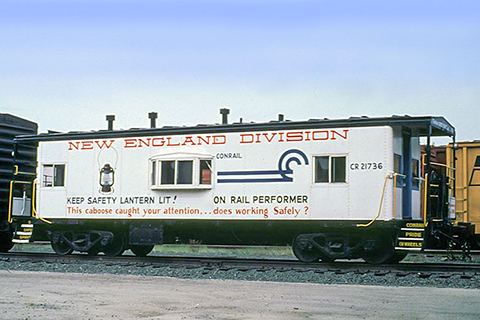 N7 class cabin car Conrail #21736 special services. 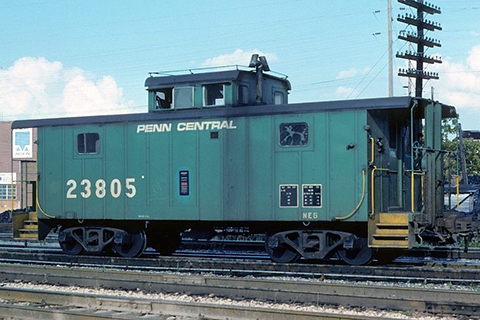 NE-6 class caboose Penn Central #23805. |

















